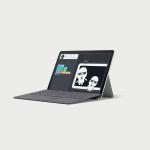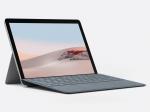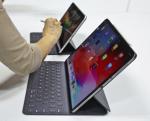Microsoft
- Microsoft's Surface Go 2 is a great tablet for entertainment and light productivity, thanks to its small size and useful kickstand.
- But to get the most out of it as a work device, you need to spend extra to purchase the keyboard cover and upgrade the processor.
- It has an advantage over the pricier iPad Pro in that it runs a desktop operating system, making it easy to work as you normally would on a laptop.
- But overall, there are other Windows devices and Chromebooks around the same price range that might be better suited for work depending on your needs.
- Visit Business Insider's homepage for more stories.
Microsoft's new miniature laptop-tablet hybrid, the Surface Go 2, sounds great on the surface.
It starts at just $400, making it more affordable than most laptops and tablets. It's small enough to tote around in a moderately sized purse or small backpack. And most of all, it has a convenient and sturdily built hinge that makes it much easier to use in a wider variety of scenarios compared to other tablets.
But the more I ended up using it, the more confused I became about who precisely this device is for. When you add up the cost of accessories and upgraded internals, you'll find that you can purchase other laptops that are similarly powerful — or even more so — for around the same price.
Still, I can't say I haven't enjoyed using the Surface Go 2. In fact, it's become a surprisingly useful companion as I've remained stuck at home in recent weeks. That's mostly thanks to its palatable size and integrated kickstand, which makes it easy to set up in any room on any nearby table or counter. If anything, the Surface Go 2 has convinced me that every tablet should have a kickstand.
The Surface Go 2 has one advantage over the iPad Pro when it comes to functioning as a work device: It runs Windows 10, a desktop operating system, rather than iPadOS like the iPad Pro, which is a mobile-first software platform. That means you'll be able to install any Windows program in the Microsoft Store and work in the desktop environment you're already familiar with on the Surface Go, rather than getting used to new gestures and apps.
However, it's difficult to pinpoint precisely why someone should buy it for two key reasons. For one, if you're investing in a Windows machine, you're probably looking for a device for getting work done. That means you'll probably end up paying much more than the starting price of $400 (more on that below).
And two, while the Go is a fine computer for light productivity and entertainment, there are probably better options with more powerful processors, sturdier keyboards, and bigger displays close to the Go 2's price range for that.
The $400 price probably isn't just $400That $400 price seems like a bargain, but the cost of the Surface Go 2 will actually amount to significantly more if you want to get the most out of it. Microsoft's keyboard for the Surface Go is $100, which means if you plan to use it as a computer you'll have to pay at least $500.
And if you are hoping to get some serious work done on this pint-sized laptop, you'll probably want to invest in the model with an Intel Core m3 chip, which starts at $630.
At that point, you're paying around $730 for the Surface Go 2, which puts it almost in the same price range as the larger and more powerful Surface Pro 7. (The entry level model starts at $750, but remember you'll still have to pay an extra $130 for the TypeCover).
You could also get something that feels a bit more like a "real" laptop, like the $650 Pixelbook Go, although that machine comes with Google's more limited ChromeOS instead of Windows 10. Better yet, you can snag a budget laptop like the Acer Swift 3 for a similar price, which runs on an Intel 10th generation Core i5 processor instead of the Surface Go 2's m3 chip and comes with much more storage for just $800.
A good secondary device, but not enough on its ownI've been using the Surface Go for a mix of work and entertainment sporadically over the past week, and there are some areas in which in succeeds and others in which it falls short.
In my experience, the Surface Go 2 is best used as an ancillary device: a complement to your primary computer. During this work-from-home period, for example, I loved removing the Surface Go 2's keyboard and propping up the screen on my coffee table next to my laptop to keep an eye on email and Slack messages. But the screen felt a bit small and cramped to serve as my main work device.
And while Microsoft's TypeCover is great for a keyboard case, it's still just that: a case. It's not quite as sturdy as what you'd get from a standard built-in keyboard on a laptop. I'd recommend it more for light productivity tasks such as checking email, taking notes, and reading.
The Go 2's size and kickstand make it great for entertainment and web browsing. But if you're looking for a non-work tablet, you're probably more inclined to go with an iPad or Android tablet, whichever lines up with your mobile device preferences.
Interestingly enough, the Surface Go 2 seems to have the opposite issue as Apple's iPad Pro. The iPad Pro, which starts at a much higher price than the entry level Surface Go 2 and also doesn't come with a keyboard, has top-tier hardware at all configurations.
All versions run on Apple's powerful A12Z Bionic processor and feature a smooth screen with a refresh rate that can reach 120Hz. But while its software has come a long way in recent years when it comes to productivity, it's still not quite as comfortable for work as Windows 10 or macOS.
The Surface Go 2, comparatively, runs on Windows 10, but you have to spend extra to get the computing power that makes it most useful for work.
Overall, I'm enjoying using the Surface Go 2 for casual tasks like watching Netflix in the kitchen and keeping an eye on work-related chats and emails when I'm away from my computer. But those use cases alone make it difficult to recommend spending upwards of $500 if you opt for the base model with the keyboard.
Chances are, if you're interested in the Go, you're probably looking for something that's a bit different than your average laptop. I'm just struggling to figure out exactly what that is.
NOW WATCH: Pathologists debunk 13 coronavirus myths
See Also:
- Lenovo's $50 webcam, down from $70, is a nice, cheap upgrade to the built-in webcams on the vast majority of laptops
- Apple's new 13-inch MacBook Pro is the best work computer for Mac fans that don't want a huge laptop
- 13 tech gifts dads will actually love to get this Father's Day
SEE ALSO: Apple's new 13-inch MacBook Pro is the best work computer for Mac fans that don't want a huge laptop




